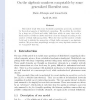Free Online Productivity Tools
i2Speak
i2Symbol
i2OCR
iTex2Img
iWeb2Print
iWeb2Shot
i2Type
iPdf2Split
iPdf2Merge
i2Bopomofo
i2Arabic
i2Style
i2Image
i2PDF
iLatex2Rtf
Sci2ools
CORR
2011
Springer
2011
Springer
On the algebraic numbers computable by some generalized Ehrenfest urns
This article deals with some stochastic population protocols, motivated by theoretical aspects of distributed computing. We modelize the problem by a large urn of black and white balls from which at every time unit a fixed number of balls are drawn and their colors are changed according to the number of black balls among them. When the time and the number of balls both tend to infinity the proportion of black balls converges to an algebraic number. We prove that, surprisingly enough, not every algebraic number can be “computed” this way.
| Added | 13 May 2011 |
| Updated | 13 May 2011 |
| Type | Journal |
| Year | 2011 |
| Where | CORR |
| Authors | Marie Albenque, Lucas Gerin |
Comments (0)

